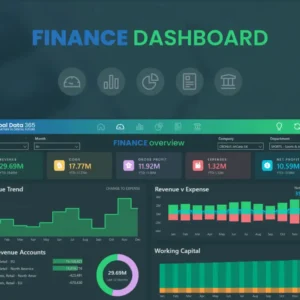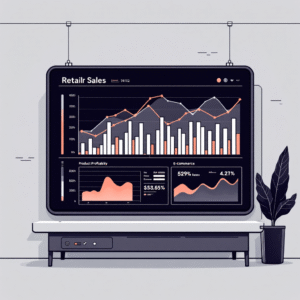Table of Contents
ToggleWhat Is Power BI (and Why It’s Everywhere)
Power BI is Microsoft’s end-to-end business intelligence platform that turns raw data into interactive dashboards and AI-assisted insights. It spans data preparation, semantic modeling, visualization, collaboration, and secure distribution.
Companies choose Power BI because it balances enterprise governance (security, lineage, lifecycle) with self-service speed (no heavy IT ticket timelines). Whether you’re a CFO validating KPIs or a product manager tracking daily active users, Power BI gives each persona a tailored experience.
Which Power BI Components? The 3 You Must Know
Power BI is often described as one product, but in practice it’s a suite. The core end-user components are:
-
Power BI Desktop – Windows application for modeling, DAX, and report authoring.
-
Power BI Service – Cloud platform for publishing, sharing, refresh, governance, and collaboration.
-
Power BI Mobile – Native iOS/Android apps for consuming dashboards and reports anywhere.
Let’s talk about your use case. If you want a quick consult or a guided build, reach us at info@powerbigate.com or +1 281-631-3767, or book a Google Meet: https://calendly.com/bilalahmad3/30min.
Power BI Desktop: Build Studio for Data Pros
Best for: Data modelers, analysts, and anyone crafting the “single source of truth.”
What you do here
-
Connect & shape data (Power Query): merge data, add calculated columns, apply transformations at scale.
-
Model: define star schemas, relationships, row-level security (RLS) roles, and calculation groups.
-
DAX & measures: build reusable business logic (e.g., YoY growth, rolling 12 months, cohort metrics).
-
Design: create page-level navigation, bookmarks, drillthrough, and dynamic tooltips.
Strengths
-
Full control over semantic models and relationships
-
Local dev performance tuning (e.g., aggregations, composite models)
-
Versioning via Git/OneDrive/SharePoint when used with PBIX/PBIP
Limitations
-
Windows-only (authoring). Mac users typically run a VM or use alternatives for light edits.
-
Not a sharing platform. Publishing and collaboration happen in the Service.
Power BI Service: Cloud Hub for Sharing & Governance
Best for: Business users, data product owners, and admins.
What you do here
-
Publish & distribute: Upload PBIX or deploy via pipelines to workspaces and apps.
-
Refresh & automation: Schedule, monitor, and alert; set up gateways for on-prem sources.
-
Govern & secure: RLS/OLS enforcement, sensitivity labels, usage metrics, data lineage, and endorsements.
-
Collaborate: Comments, subscriptions, scorecards/goals, and Share/Teams integration.
Strengths
-
Scales sharing from a team workspace to org-wide apps
-
Centralized datasets reused by many reports (reduces duplication)
-
Lifecycle management with deployment pipelines (Dev → Test → Prod)
Limitations
-
Deep modeling is not done here (that’s Desktop).
-
Premium features (e.g., large models, incremental refresh at scale) may need Fabric/Power BI Premium.
Power BI Mobile: Insights Anywhere
Best for: Executives, sales leaders, and field teams who need quick answers on the go.
What you do here
-
Consume, not build: Interact with dashboards and reports, annotate, and share snapshots.
-
Mobile-optimized views: Authors can design phone layouts in Desktop for perfect mobile UX.
-
Alerts: Trigger push notifications when KPIs cross thresholds.
Strengths
-
Native touch gestures, offline caching, and location-aware visuals
-
Instant context sharing (send a filtered screenshot with a note)
Limitations
-
Primarily consumption; complex edits belong in Desktop.
-
Requires authors to design phone-optimized layouts for the best experience.
How the Pieces Fit: A Simple Architecture
Data Sources (ERP, CRM, SaaS, Files, DBs)
│
▼
Power BI Desktop ──► PBIX / Dataset (Model + Measures + Report)
│ │
▼ ▼
Publish ▶▶▶▶▶▶▶▶▶▶ Power BI Service (Workspaces, Apps, Refresh, RLS)
│
▼
Power BI Mobile (Consume)
Think of Desktop as authoring, Service as distribution & governance, and Mobile as consumption.
Feature Comparison: Desktop vs Service vs Mobile
| Capability | Desktop | Service | Mobile |
|---|---|---|---|
| Data connect & transform | ✅ | ⚠️ (limited) | ❌ |
| Modeling (relationships, DAX) | ✅ | ⚠️ (minor edits) | ❌ |
| Report authoring | ✅ | ⚠️ (quick edits) | ❌ |
| Publish/share | ⚠️ (publish only) | ✅ | ⚠️ (share snapshot) |
| Scheduled refresh | ❌ | ✅ | N/A |
| Row-level security enforcement | Define roles | Enforce | Enforce (view) |
| Deployment pipelines | ❌ | ✅ | ❌ |
| Usage metrics & lineage | ❌ | ✅ | ❌ |
| Mobile-optimized views | Design phone layout | Host/distribute | Consume (native) |
| Alerts & subscriptions | ❌ | ✅ | ✅ (receive) |
Legend: ✅ Full | ⚠️ Partial | ❌ Not applicable
When to Use Which Component (Decision Guide)
Use Desktop when…
-
You’re building or evolving a data model.
-
You need advanced DAX, composite models, aggregations, or calculation groups.
-
You want to create pixel-perfect report pages and phone layouts.
Use Service when…
-
You’re publishing, sharing, and governing artifacts.
-
You need scheduled refresh, usage metrics, deployment pipelines, or app distribution.
-
You’re managing gateways, RLS, or sensitivity labels.
Use Mobile when…
-
Leaders and field teams need answers on the move.
-
Alerts should push insights (e.g., inventory levels, daily sales).
-
You’ve designed phone-friendly pages and want high adoption.
Quick “Chart”: Typical Time Spent by Role (Illustrative)
Data Engineer: ▉▉▉▉▉▉▉▉▉ Desktop ▉▉▉ Service ▉ Mobile
BI Developer: ▉▉▉▉▉▉▉▉▉ Desktop ▉▉▉▉ Service ▉ Mobile
Exec/User: ▉ Desktop ▉▉▉▉▉▉ Service ▉▉▉▉▉▉▉▉ Mobile
Performance, Cost & Governance Essentials
-
Data Model First: A clean star schema with conformed dimensions beats any visual trick. Keep columns minimal, measures reusable, and relationships clear.
-
Incremental Refresh: Move heavy fact tables to incremental policies (Premium/Fabric) to reduce refresh windows and costs.
-
Shared Datasets: One certified dataset powering many reports improves trust, reduces duplication, and simplifies change management.
-
Security: Implement RLS at the dataset; verify with test users in the Service. Consider Object-Level Security for sensitive tables/measures.
-
Metadata & Lineage: Use endorsements and descriptions; monitor lineage to understand upstream blasts and ensure reliable data governance.
-
Adoption: Design phone layouts and bookmark-driven stories. Provide a one-page “how to read this dashboard” for each audience.
Want a governed setup with the right KPIs? Our guides can help:
• 10 Essential Financial KPIs Every Power BI Dashboard Should Track
• Power BI Metadata Management
Common Pitfalls—and How to Avoid Them
-
Model in the visuals (too many calculated columns/measures without a schema).
-
Fix: Build a star schema; use measures over calculated columns for aggregations.
-
-
Massive PBIX files slowing everything down.
-
Fix: Remove unused columns, disable auto date/time, use aggregations and incremental refresh.
-
-
One dataset per report (duplication).
-
Fix: Publish shared, certified datasets; reference them for many thin reports.
-
-
No governance (wild west of workspaces).
-
Fix: Adopt deployment pipelines, endorsements, sensitivity labels, and admin policies.
-
-
Ignoring mobile.
-
Fix: Build phone layouts in Desktop; enable alerts in Service; test on devices.
-
-
Unclear KPI definitions.
-
Fix: Standardize KPI logic in a semantic model with documented measures and descriptions.
-
60-Minute Starter Plan
Minute 0–10: Define the question
-
Who is the audience? Which decisions will this dashboard inform? (e.g., weekly cash, churn, MRR)
Minute 10–25: Connect & shape in Desktop
-
Pull from a CRM/export file; clean columns, create a date table, mark it as a date table.
Minute 25–40: Model & measures
-
Build a simple star schema (FactSales, DimCustomer, DimDate).
-
Add measures:
Total Sales,YoY Sales,Active Customers,Gross Margin %.
Minute 40–50: Design report
-
2–3 visuals per page; bookmark a “Highlights” view.
-
Add a phone layout.
Minute 50–60: Publish & share via Service
-
Publish to a workspace, set scheduled refresh, add RLS if needed.
-
Share as an App; subscribe key stakeholders and set alerts on KPIs.
FAQ
Q1: Do I need a Premium license to use all three components?
No. You can use Desktop (free) and publish to the Service with Pro licenses for creators/consumers in many SMB scenarios. Premium/Fabric adds capacity features: large models, advanced refresh, and enterprise scale.
Q2: Can I build on a Mac?
Desktop is Windows-only. Many authors use a Windows VM or a separate Windows machine for modeling, then use the Service for distribution and light edits.
Q3: What’s the difference between a Workspace and an App in the Service?
A Workspace is where your team builds and manages artifacts. An App is a curated, read-only package you publish for broader audiences with navigation, theming, and permissions.
Q4: How do I make reports fast on Mobile?
Use phone-optimized pages, avoid overly dense visuals, and pre-filter to the essentials. Test with real users and set alerts for proactive updates.
Q5: How do I protect sensitive metrics?
Implement RLS/OLS, sensitivity labels, and workspace roles. Keep secrets out of reports and use gateways for on-prem data.
Summary
Power BI combines Desktop (craft the model and experience), Service (publish, govern, and collaborate), and Mobile (consume anywhere) into a powerful analytics pipeline. Use Desktop for building, Service for sharing & governance, and Mobile for impactful consumption. With the right model, refresh strategy, and governance, you’ll deliver trusted, mobile-ready insights that scale with your business.
Related Reading on PowerBIGate
-
Essential Financial KPIs Every Power BI Dashboard Should Track
-
10 Essential Financial KPIs Every Power BI Dashboard Should Track
Call to Action
Ready to set up a governed, mobile-ready Power BI stack—or refactor your current one?
Email: info@powerbigate.com | Phone: +1 281-631-3767 | Book a Meet: https://calendly.com/bilalahmad3/30min
Bonus: Simple KPI Readiness Table (for your next planning session)
| Area | Starter Checklist | Why It Matters |
|---|---|---|
| Modeling | Star schema, date table, core measures | Reliable, reusable analytics across reports |
| Governance | Workspaces, roles, RLS/OLS, endorsements | Trust, security, and reduced shadow IT |
| Refresh | Gateways, incremental policies, SLA | Fresh, cost-efficient data at scale |
| Distribution | Apps, subscriptions, alerts, usage metrics | Adoption and proactive decision-making |
| Mobile | Phone layouts, KPI alerts, offline | Executive and field readiness |







